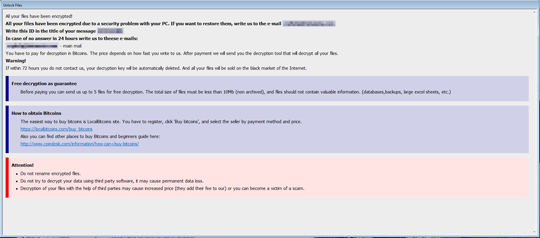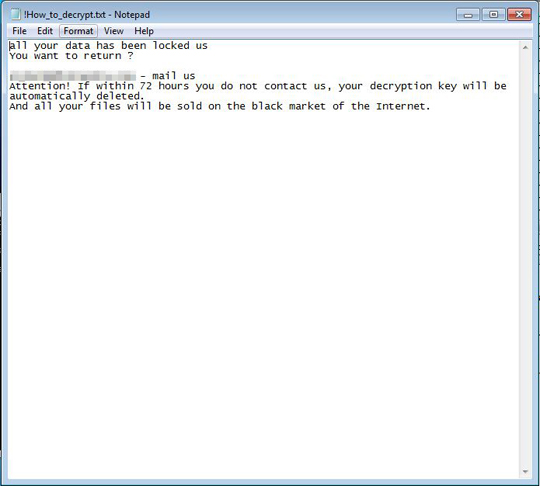Ransom_MEDUZA.THHOBAH
Gen:Heur.Ransom.Imps.1 (Bitdefender), Trojan:Win32/Occamy.B (Microsoft)
Windows


Threat Type: Ransomware
Destructiveness: No
Encrypted: No
In the wild: Yes
OVERVIEW
Downloaded from the Internet, Dropped by other malware
This Ransomware arrives on a system as a file dropped by other malware or as a file downloaded unknowingly by users when visiting malicious sites.
It drops files as ransom note.
TECHNICAL DETAILS
17,920 bytes
EXE
No
02 Aug 2018
Drops files, Terminates processes, Displays message/message boxes, Encrypts files
Arrival Details
This Ransomware arrives on a system as a file dropped by other malware or as a file downloaded unknowingly by users when visiting malicious sites.
Installation
This Ransomware drops the following files:
- %User Startup%\ITunes.hta ← It drops the following file to enable the ransom note to pop up at every system startup
- %User Profile%\aesKey.bin
(Note: %User Startup% is the current user's Startup folder, which is usually C:\Windows\Profiles\{user name}\Start Menu\Programs\Startup on Windows 98 and ME, C:\WINNT\Profiles\{user name}\Start Menu\Programs\Startup on Windows NT, C:\Documents and Settings\{User name}\Start Menu\Programs\Startup on Windows XP, or C:\Users\{user name}\AppData\Roaming\Microsoft\Windows\Start Menu\Programs\Startup on Windows Vista, 7, and 8.. %User Profile% is the current user's profile folder, which is usually C:\Documents and Settings\{user name} on Windows 2000, XP, and Server 2003, or C:\Users\{user name} on Windows Vista, 7, and 8.)
It adds the following mutexes to ensure that only one of its copies runs at any one time:
- NET CLR Google
Process Termination
This Ransomware terminates the following processes if found running in the affected system's memory:
- notepad.exe
- excel.exe
- mysql.exe
Other Details
This Ransomware does the following:
- It avoids encrypting files with the following extensions:
- .exe
- .dll
- .ink
- .meduza
- .bin
- It encrypts files found in all fixed, removable and network drives.
- It displays the following upon successful encryption and at every system startup
Ransomware Routine
This Ransomware avoids encrypting files with the following strings in their file path:
- $Recycle.Bin
- Boost
- ProgramData
- Windows
- ProgramFiles
It appends the following extension to the file name of the encrypted files:
- .[cryhelp@tutanota.com].meduza
It drops the following file(s) as ransom note:
- {Encrypted Directory}\!How_to_decrypt.txt
SOLUTION
9.850
14.418.04
02 Aug 2018
14.419.00
03 Aug 2018
Step 1
Before doing any scans, Windows XP, Windows Vista, and Windows 7 users must disable System Restore to allow full scanning of their computers.
Step 2
Note that not all files, folders, and registry keys and entries are installed on your computer during this malware's/spyware's/grayware's execution. This may be due to incomplete installation or other operating system conditions. If you do not find the same files/folders/registry information, please proceed to the next step.
Step 3
Identify and terminate files detected as Ransom_MEDUZA.THHOBAH
- Windows Task Manager may not display all running processes. In this case, please use a third-party process viewer, preferably Process Explorer, to terminate the malware/grayware/spyware file. You may download the said tool here.
- If the detected file is displayed in either Windows Task Manager or Process Explorer but you cannot delete it, restart your computer in safe mode. To do this, refer to this link for the complete steps.
- If the detected file is not displayed in either Windows Task Manager or Process Explorer, continue doing the next steps.
Step 4
Search and delete these files
- %User Startup%\ITunes.hta
- {Encrypted Directory}\!How_to_decrypt.txt
- %User Profile%\aesKey.bin
Step 5
Scan your computer with your Trend Micro product to delete files detected as Ransom_MEDUZA.THHOBAH. If the detected files have already been cleaned, deleted, or quarantined by your Trend Micro product, no further step is required. You may opt to simply delete the quarantined files. Please check the following Trend Micro Support pages for more information:
Step 6
Restore encrypted files from backup.
Did this description help? Tell us how we did.



